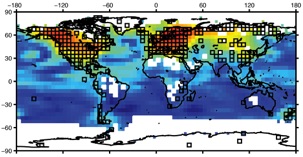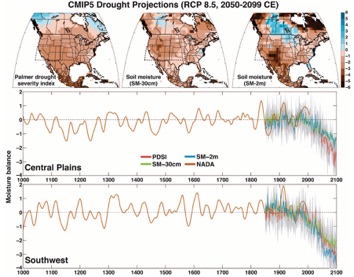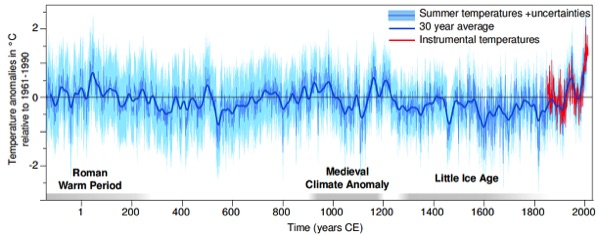About
The PaleoDynamics Lab at the Lamont-Doherty Earth Observatory is led by Prof. Jason E. Smerdon, with strong connections to colleagues in the Division of Ocean and Climate Physics, the Lamont Tree-Ring Laboratory and the NASA Goddard Institute for Space Studies. The broad objective of our group is to characterize and understand

climate variability and change on multi-decadal to centennial timescales. Climate research is limited in its ability to understand these climatic variations directly from the instrumental record because such observations are not widely available for more than about 100-150 years. To circumvent this limitation, modern instrumental records are supplemented with climatic proxy records and climate model simulations to help characterize these low-frequency modes of change. Our group uses numerical models, climate proxy records and statistical methods to better understand the variability of climate over decades to centuries. We are particularly interested in how multiple climate proxies can be combined to yield hemispheric and global maps of climate variability spanning the Common Era (the last two thousand years), how climate models represent climatic change over this time period, and how to use model-data comparisons on paleoclimatic timescales to inform future climate projections. Several of our recent efforts are highlighted below and all of our publications are publicly available at our Publications page.

In the Southwest and Central Plains of Western North America, climate change is expected to increase drought severity in the coming decades. These regions nevertheless experienced extended Medieval-era droughts that were more persistent than any historical event, providing crucial targets in the paleoclimate record for benchmarking the severity of future drought risks. We use an empirical drought reconstruction and three soil moisture metrics from 17 state-of-the-art general circulation models to show that these models project significantly drier conditions in the later half of the
Recent international initiatives have expanded the number of high-quality proxy-records and developed new statistical reconstruction methods. These advances allow more rigorous regional past temperature reconstructions and, in turn, the possibility of evaluating climate models on policy-relevant, spatiotemporal scales. This study provides a new proxy-based, annually-resolved, spatial reconstruction of European summer (June–August) temperature fields back to 755 CE based on Bayesian hierarchical modelling (BHM), together with estimates of the European mean temperature variations since 138 BCE based on BHM and composite-plus-scaling (CPS). The reconstructions compare well with independent instrumental and proxy-based temperature estimates, but suggest a larger amplitude in summer temperature variability than previously reported. Both CPS and BHM reconstructions indicate that the mean 20th century European summer temperature was not significantly different from some earlier centuries, including the 1st, 2nd, 8th and 10th centuries CE. Recent summers, however, have been unusually warm in the context of the last two millennia and there are no 30-yr periods in either reconstruction that exceed the mean average European summer temperature of the last three decades (1986–2015 CE). These reconstructions are also compared to an ensemble of climate model simulations, which suggest that the reconstructed European summer temperature variability over the period 850–2000 CE reflects changes in both internal variability and external forcing on multi-decadal timescales.
21st century compared to the 20th century and earlier paleoclimatic intervals. This desiccation is consistent across most of the models and moisture balance variables, indicating a coherent and robust drying response to warming despite the diversity of models and metrics analyzed. Notably, future drought risk will likely exceed even the driest centuries of the Medieval Climate Anomaly (1100–1300 CE) in both moderate (RCP 4.5) and high (RCP 8.5) future emissions scenarios, leading to unprecedented drought conditions during the last millennium.
We use a suite of climate datasets and multiple representations of atmospheric moisture demand to calculate many different estimates of the self-calibrated Palmer Drought Severity Index, a proxy for near-surface soil moisture, across California from 1901 to 2014 at high spatial resolution. Using this ensemble of calculations, we show that California drought conditions were record breaking in 2014, but the 2012–2014 average was likely not record breaking, contrary to prior findings. On a regional basis, the 2012–2014 drought was record breaking, however, in the agriculturally important southern Central Valley and highly populated coastal areas (see the above figure). We also examined the individual contributions of specific climate variables to the recent drought, including the temperature component associated with anthropogenic warming. We find that precipitation is the primary driver of drought variability, but anthropogenic warming is estimated to have accounted for 8-27% of the observed drought anomaly in 2012–2014 and 5-18% in 2014. Although natural variability has be the dominant driver of the recent California drought, anthropogenic warming has substantially increased the overall likelihood of extreme California droughts and contributed to the severity of the current drought in the state.

